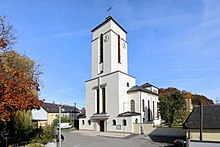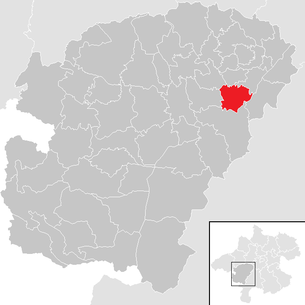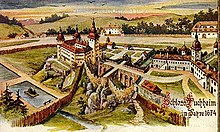Attnang-Puchheim
|
Borough Attnang-Puchheim
|
||
|---|---|---|
| coat of arms | Austria map | |
|
|
||
| Basic data | ||
| Country: | Austria | |
| State : | Upper Austria | |
| Political District : | Vöcklabruck | |
| License plate : | VB | |
| Main town : | Attnang | |
| Surface: | 12.32 km² | |
| Coordinates : | 48 ° 1 ' N , 13 ° 44' E | |
| Height : | 416 m above sea level A. | |
| Residents : | 9,100 (January 1, 2020) | |
| Postal code : | 4800 | |
| Area code : | 07674 | |
| Community code : | 4 17 03 | |
| NUTS region | AT315 | |
| Address of the municipal administration: |
Rathausplatz 9 4800 Attnang-Puchheim |
|
| Website: | ||
| politics | ||
| Mayor : | Peter Groiß ( SPÖ ) | |
|
Municipal Council : (2015) (37 members) |
||
| Location of Attnang-Puchheim in the Vöcklabruck district | ||
| Source: Municipal data from Statistics Austria | ||
Attnang-Puchheim is a municipality in the Hausruckviertel in the Vöcklabruck district in Upper Austria , at the intersection of the Vienna – Salzburg (Westbahn) railway with the Salzkammergutbahn , with 9100 inhabitants (as of January 1, 2020). The responsible judicial district is Vöcklabruck . The confluence of the Aurach and the Ager lies near Attnang-Puchheim .
geography
Attnang-Puchheim is 416 m above sea level in the Hausruckviertel. The extension is 4.8 km from north to south and 4.1 km from west to east. The total area is 12.32 km². 38.7% of the area is forested, 36.3% of the area is used for agriculture.
Community structure
The municipal area comprises the following 10 localities (population in brackets as of January 1, 2020):
- Aham (58)
- Aichet (74)
- Attnang (3356)
- Hohenbaumgarten (217)
- Landertsham (3)
- Niederstrasse (1422)
- Oberstrasse (801)
- Puchheim (2985)
- Sonnleithen (53)
- Steinhübl (131)
The community consists of the cadastral community Attnang-Puchheim.
Neighboring communities
| Pilsbach | Pühret | Redlham |
| Vöcklabruck |

|
Desselbrunn |
history
Attnang and Puchheim developed from settlements by Bavarian immigrants in the late 8th century to the beginning of the 11th century . Puchheim is first mentioned in 1135 and Attnang as Otenang around a hundred years later, in 1242. Only in 1912 was the community name Puchheim changed to Attnang-Puchheim due to the growing importance of the Neu-Attnang district .
In some writings, the year 1050 is mentioned as the date of construction for the construction of the festivals on the grove on the beech hill, but there is no documentary evidence of this. In 1585 the fortress burned down completely. Puchheim Castle, built in the following years, essentially corresponds to its present form.
The history of Attnang and Puchheim was largely influenced by the owners of Feste Puchheim until 1870. Today the castle with the beautiful arcade courtyard is a monastery and is owned by the Redemptorists who have been called to Puchheim for pastoral care . These were summoned in 1851 by Archduke Maximilian Joseph of Austria-Este , the then lords of Puchheim Castle. The pre-castle is owned by the municipality and the diocese of Linz .
In the castle chapel, which is consecrated to St. George , the last Spanish pretender to the throne of the first Carlist dynasty, Alfonso Carlos (I) of Bourbon and Austria-Este and his wife Maria das Neves of Portugal and the Duchess Maria Antonia of Bourbon , who died in 1936, were seated -Parma 1959 and her son, Prince René of Bourbon-Parma 1962 buried.
The last Austrian Empress Zita von Bourbon-Parma visited Austria in 1982 after a long exile, after Federal Chancellor Bruno Kreisky had made it possible for her to enter the country without renouncing the throne, contrary to the law. She came to Puchheim to commemorate her mother, Maria Antonia von Bourbon-Parma, at the grave.
Under Rector P. Matthias Paprian, the large pilgrimage basilica Maria Puchheim was built from 1886 to 1890, which was built in 1951 by Pius XII. was elevated to a minor basilica . It contains a Breinbauer organ from 1891. With 1,647 pipes on 24 registers, it is a medium-sized instrument, but quite large for the period of the romantic organs of the 19th century. Orgelbau Kuhn from Männedorf renovated the instrument in 2006. The precious instrument is also used in concert.
With the construction of the Salzkammergutbahn and its commissioning in 1877, the development of the place was set to a significant railway junction , since Attnang-Puchheim was already the terminus and transshipment point of the Niederstrasser-Bahn , the first coal railway in Austria.
Towards the end of the Second World War , Attnang-Puchheim was badly damaged by American bombing raids on April 21, 1945, especially since the Allies feared supplies for the Nazis' alleged Alpine fortress . The attack by 300 aircraft lasted three hours. At least 700 people died in the hail of bombs (out of 2,340 bombs containing 640 tons of explosives), including many refugees from the eastern regions and from Silesia who were hit on trains at the station. The station also acted as a reloading station for a secret missile test facility in the Redl-Zipf subcamp . The attack made Attnang-Puchheim the city with the highest death rate in Austria during World War II.
After the end of the war, Attnang-Puchheim became an important place with industry and commerce as well as a large train station through the reconstruction; here the locomotives had to be changed, as electrification ended in Attnang.
In 1955 it was decided to make Attnang-Puchheim a market town because of the great reconstruction effort after the war . On March 3, 1990, the city was raised .
Population development

Culture and sights

- Around 800 years ago a so-called fortress was built, completely destroyed by fire in 1585, after which the castle was rebuilt in its current form. Today Schloss Puchheim houses a gallery for contemporary art - the Galerie Schloss Puchheim, and an art library .
- The ground-breaking ceremony for the pilgrimage church took place on February 24, 1886 and the consecration on August 5, 1890. The interior design and furnishings, however, continued until August 1896. In 1951 the church was opened by Pope Pius XII. elevated to a "minor basilica" and has been a parish church since "Maria Puchheim" was established on February 1, 1968.
- Due to the strong growth of the place and the relocation of the center around the station, the construction of a larger parish church became necessary. It was not until 1951 that the finished church, which was built according to plans by Hans Feichtlbauer , was consecrated by Prelate Leopold Hager, provost of St. Florian Monastery. Most of the interior fittings in a modern form, but made from one piece, come from the Klothilde Rauch sculptor's workshop in Altmünster. The focal point above the high altar is a crucifix by the sculptor Franz Forster from St. Florian, the glass windows, which match the style of the interior, are from the Viennese company Greyling and are based on designs by the Viennese painter Lucia Jirgal . The large and beautiful Christmas crib is the work of F. Binder (figures) and N. Stüger (landscape) from Steinkogl near Ebensee.
- First documented mention in 1367, probably built between the 9th and 11th centuries. Since the completion of the Holy Spirit Church in the center of Attnang in 1936, the Martinskirche has mainly served the population as a burial and wedding church.
- Puchheim basement stage
- In 1965 Werner Böhm and some like-minded people founded a basement stage in the substructure of the Puchheim basilica. Since then, 85 theater productions have been realized there. A total of around 300 theater enthusiasts from Attnang-Puchheim and the neighboring communities worked on it. In 1993 the company started its own children's and youth program. Since 1998 "N2O", the improv group of the Puchheim basement stage, has been providing monthly challenges. Some renovation phases - most recently in 2009 - required investments in the higher six-digit range. One of the results of this is probably the smallest revolving stage not only in Upper Austria, but in all of Austria. Today the auditorium offers space for 127 people with good visibility throughout.
Inner courtyard of the Puchheim castle with a copper beech that has been designated a natural monument
Economy and Infrastructure
Attnang-Puchheim has a number of large companies. The largest company is the STIWA Group . More than 1000 people are employed with external locations. At the Spitz company , around 650 employees produce food that is sold through the Hofer retail chain .
traffic
Attnang-Puchheim is a traffic junction.
Rail transport
See also: Attnang-Puchheim train station
The double-track, electrified Westbahn runs through Attnang-Puchheim, which gives the city a supraregional significance. In addition, the station offers connections to the Salzkammergutbahn in the direction of the Gmunden district all the way to Stainach - Irdning in Styria , as well as a railway line to Schärding via Ried im Innkreis . The single-track section to Stainach-Irdning is electrified, but the single-track section to Schärding is not. Since the timetable change in 2007, trains have been running from Linz to Stainach-Irdning and vice versa in order to reduce changes at the Attnang train station. Although the Kammerer Bahn only branches off the Westbahn in the municipality of Timelkam , all trains to Schörfling am Attersee run from Attnang-Puchheim. Due to the many connection options, Attnang-Puchheim functions as a railway junction where InterCity trains also stop. A renovation of the station was completed in 2014.
Road traffic
- The Bundesstraße 1 - from Salzburg to Vienna - runs parallel to the West Autobahn A 1 and runs through the municipality .
- About eight kilometers south of the city center is the Regau motorway junction to the West motorway A 1.
Bus transport
Surrounding communities can be easily reached by bus from Monday to Saturday during the day. In addition to the bus connections to Vöcklabruck, Schörfling am Attersee and Schwanenstadt, there is also a city bus and city taxi in Attnang-Puchheim.
politics
The municipal council with a total of 37 members has had the following distribution since the municipal council and mayoral elections in Upper Austria in 2015 : 15 SPÖ, 10 FPÖ, 8 ÖVP and 4 GREENS.
mayor
- since 2009 Peter Groiß (SPÖ)
coat of arms
Blazon (official description of the municipal coat of arms ): Divided and half-split ; above in gold over red flames a black phoenix ready to fly ; below right a golden heraldic lily in blue , below left three times split by silver and red . The community colors are red-yellow-blue.
The coat of arms was awarded to Attnang-Puchheim on the occasion of the market survey in 1955. The phoenix rising from the ashes symbolizes the reconstruction of the place after the heavy destruction by bombs in the Second World War. The lily comes from the coat of arms of the Salburg family, the former owners of the Puchheim rulership, and is at the same time a symbol for Maria , the patroness of the Puchheim pilgrimage church. The white and red posts are taken from the Upper Austrian coat of arms .
Town twinning
Personalities
sons and daughters of the town
- Pilgrim II of Puchheim (1330-1396), Archbishop of Salzburg
- Franz Koch (1888–1969), Germanist
- Max Lammer (1905–1966), actor
- Franz Neudorfer (1919–1984), politician (ÖVP) and railway official
- Friedrich Peter (1921–2005), politician, from 1958 to 1978 FPÖ party chairman
- Hubert Kronlachner (1923–2015), actor and radio play speaker
- Edith Dobesberger (1925–2002), teacher and politician (SPÖ)
- Helmut Zehetmair (* 1935), musician
- Ludwig Bieringer (* 1943), politician (ÖVP)
- Gerhard Fitzinger (1947–2016), composer, music teacher and church musician
- Maria Fekter (* 1956), politician (ÖVP), 2008–2011 Minister of the Interior, 2011–2013 Minister of Finance in the Austrian Federal Government
- Carola Mair (* 1962), documentary filmmaker and screenwriter
- Martin Schermaier (* 1963), legal historian
- Angelika Winzig (* 1963), politician (ÖVP) and entrepreneur
- Hannes Maxwald (* 1968), motorcycle racer
Personalities associated with the city
- Oskar Aichinger (* 1956), composer and pianist
- Johanna Bassani (2002-2020), Nordic combined athlete
- Marie-José Gröger (* 1938), painter and graphic artist
- Judith Gruber-Rizy (* 1952), writer
- Maria Koller-Feuchtinger (1897–1987), councilor in Attnang-Puchheim and member of the state parliament (SPÖ)
Honorary ring bearer
- Bruno Primetshofer CSsR (1929–2014), Roman Catholic religious and canon lawyer
literature
- Helmut Böhm: 1945 - the day of tears - Attnang-Puchheim in the hail of bombs from two US air fleets - documentation based on the latest research results , Verlag Moserbauer, Ried im Innkreis 2007, ISBN 978-3-902121-86-8
- Helmut Böhm (ed.): 750 years of Attnang. A documentation in words and pictures about the history of the town of Attnang-Puchheim 1242–1992. City municipality, Attnang-Puchheim 1992.
- Friedrich Steffe: The history of the rule Puchheim in Austria above the Enns. Innsbruck 1950.
- Kurt Palm : No place. Nowhere. Local inspection, Festival of the Regions. In: Der Standard, 25./26. June 2011 ( online, derStandard.at ›Culture› Culture & Politics ›Cultural Policy of the Federal States , June 24, 2011, https)
Web links
- Municipality website
- Map in the Digital Upper Austrian Room Information System ( DORIS )
- 41703 - Attnang-Puchheim. Community data, Statistics Austria .
- Further information about the municipality of Attnang-Puchheim can be found on the geographic information system of the federal state of Upper Austria .
Individual evidence
- ↑ Statistics Austria: Population on January 1st, 2020 by locality (area status on January 1st, 2020) , ( CSV )
- ↑ Helmut Böhm: 1945 - the day of tears. Attnang-Puchheim in the hail of bombs from two US air fleets. Documentation based on the latest research results. Moserbauer, Ried im Innkreis 2007. ISBN 978-3-902121-86-8 .
- ↑ Johannes Hintermaier: All roads lead to Nang-Pu . In Bilder und Zeiten , supplement to the FAZ from May 28, 2011, No. 124, room ( online ).
- ↑ Date 03/05 : Detailed article about April 21, 1945, when Attnang-Puchheim became the place with the highest death rate in Austria during World War II ( Memento from June 23, 2012 in the Internet Archive )
- ^ Province of Upper Austria: Coat of arms of the municipality of Attnang-Puchheim














